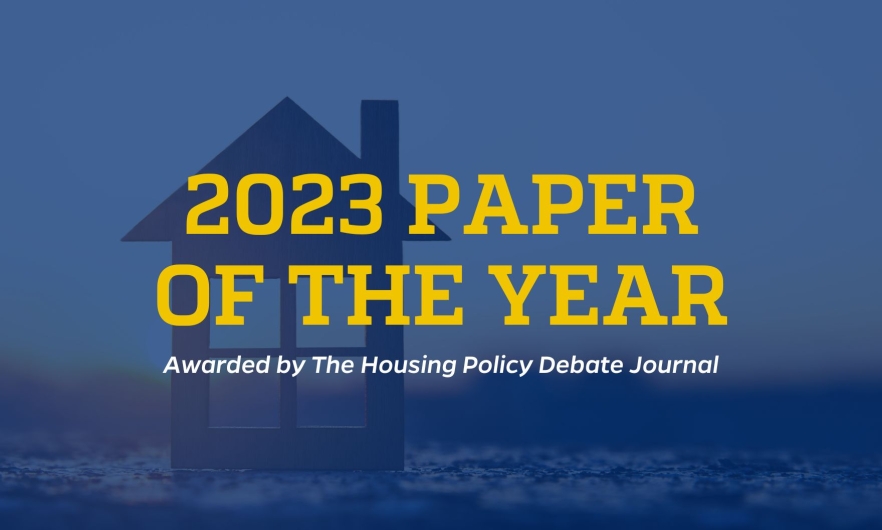Study Linking Housing Mobility to Reduced Health Care Use Recognized as Paper of the Year
Decades’ worth of data shows long-lasting impacts of moving to high-income neighborhoods on children’s health.

A study led by Craig Pollack, PhD, professor in Health Policy and Management, has been named 2023 Paper of the Year by the journal Housing Policy Debate for its insights into the role of housing mobility on long-term health care use. Researchers linked decades’ worth of hospital discharge and Medicare data to participants in the U.S. Department of Housing and Urban Development’s Moving to Opportunity (MTO) program and found that hospital admissions and long-term health care use were significantly lower for children in the program.
Specifically, the study finds that children with housing vouchers granting them an opportunity to move to low-poverty neighborhoods are hospitalized for asthma 36% less often and have 30% fewer hospitalizations for mental health than children in the control group. Health care data from over 9,000 children who signed up for the MTO experiment in the 1990s was examined.
"There is strong evidence that housing policies, particularly those that reduce childhood exposure to neighborhood poverty, can have long-term health benefits," said Pollack. "The large reductions in hospitalizations not only for asthma but also for mental health suggest that improving neighborhood environments is an important public health intervention."
Other key findings from the study showed that voucher recipients also demonstrated lower use of psychiatric services, outpatient hospital care, and clinic-based care. Thus, such reductions may suggest that this potential move to higher-income neighborhoods can reduce demands on various medical equipment and supportive services such as durable medical equipment.
Whereas the study results yielded significant gains for children, those for adults were not as strong. The analysis did not find differences in health care use between adults in the voucher-group and control-groups, even though prior research suggested that better neighborhood conditions benefit adults' health.
The U.S. Department of Housing and Urban Development created the Moving to Opportunity program to test the hypothesis that assisting families in moving from high-poverty areas to areas with lower poverty would improve their quality of life. The participants were randomly assigned to one of three groups: one received vouchers restricted to low-poverty areas, another received traditional housing vouchers, and the third did not accept vouchers. The current study analyzed the two voucher groups together because their experiences of neighborhood poverty were similar.
Previous research using the MTO experiment found that children who moved to neighborhoods with a lower level of poverty did better in later life economically and educationally. This latest research is an extension of these findings, demonstrating yet another long-term quality of life effect: that better neighborhood environments in childhood translate to lower health care costs later in life.
The findings have implications for both housing and health care policy. "Our findings support the notion that housing is health care," said Pollack. "Policies that facilitate the ability of low-income families to move to better neighborhoods not only improve living conditions but can also lead to significant health benefits, especially for children."
The study’s focus aligns with recent federal initiatives to better weave together housing and health care policies. HUD recently began to scale up its housing mobility programs, which help families overcome several barriers to renting homes in neighborhoods of opportunity. Meanwhile, health care policymakers increasingly recognized that the social determinants-housing, education, and income-were the major drivers of health outcomes.
This study’s findings set up a number of directions for future research and policy development. Further research is needed to explore why benefits were more pronounced for children than for adults, and how specific neighborhood characteristics influence health outcomes.
Housing programs could further capitalize on this move to low-poverty neighborhoods for longitudinal health benefits by offering health education and resources to the family. Health care providers and policymakers might also work closer with housing authorities to better address the social drivers of health disparities.
With the cost of housing assistance programs often cited as a barrier to their expansion, the study suggests that the savings resulting from reduced hospitalizations could offset some of the costs. The study contributes to the growing body of evidence that explores the intersection between housing and health and informs and guides programs addressing both issues in a way that can substantially better the lives of low-income families.
For more insights into the connection between housing and health and creative solutions to housing challenges, please visit the Hopkins Housing & Health Collaborative.





